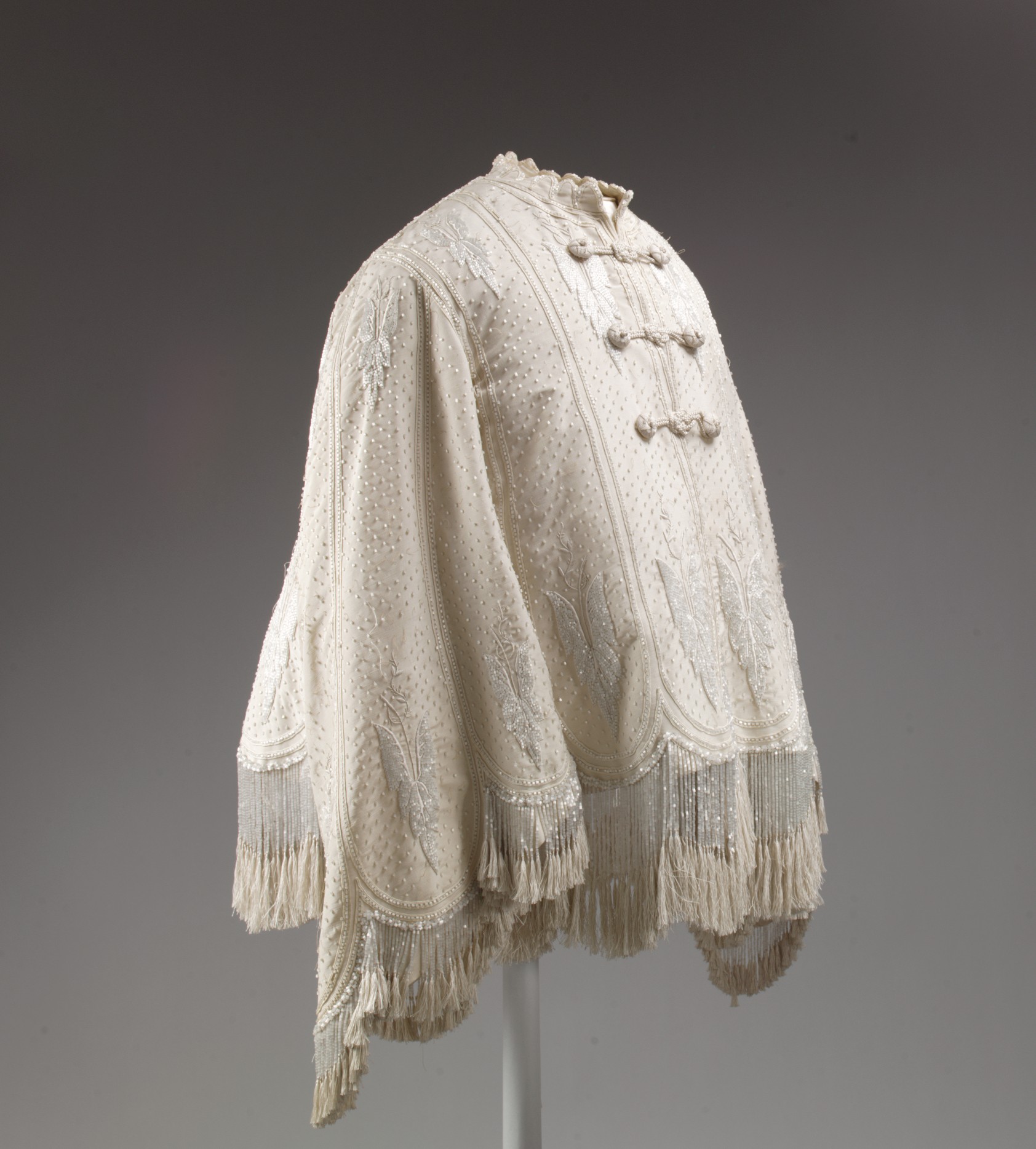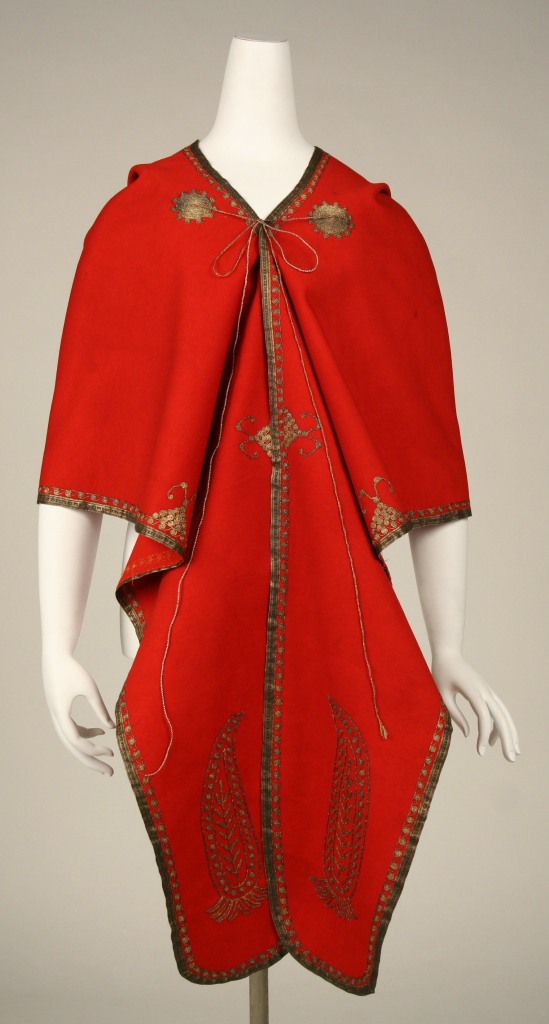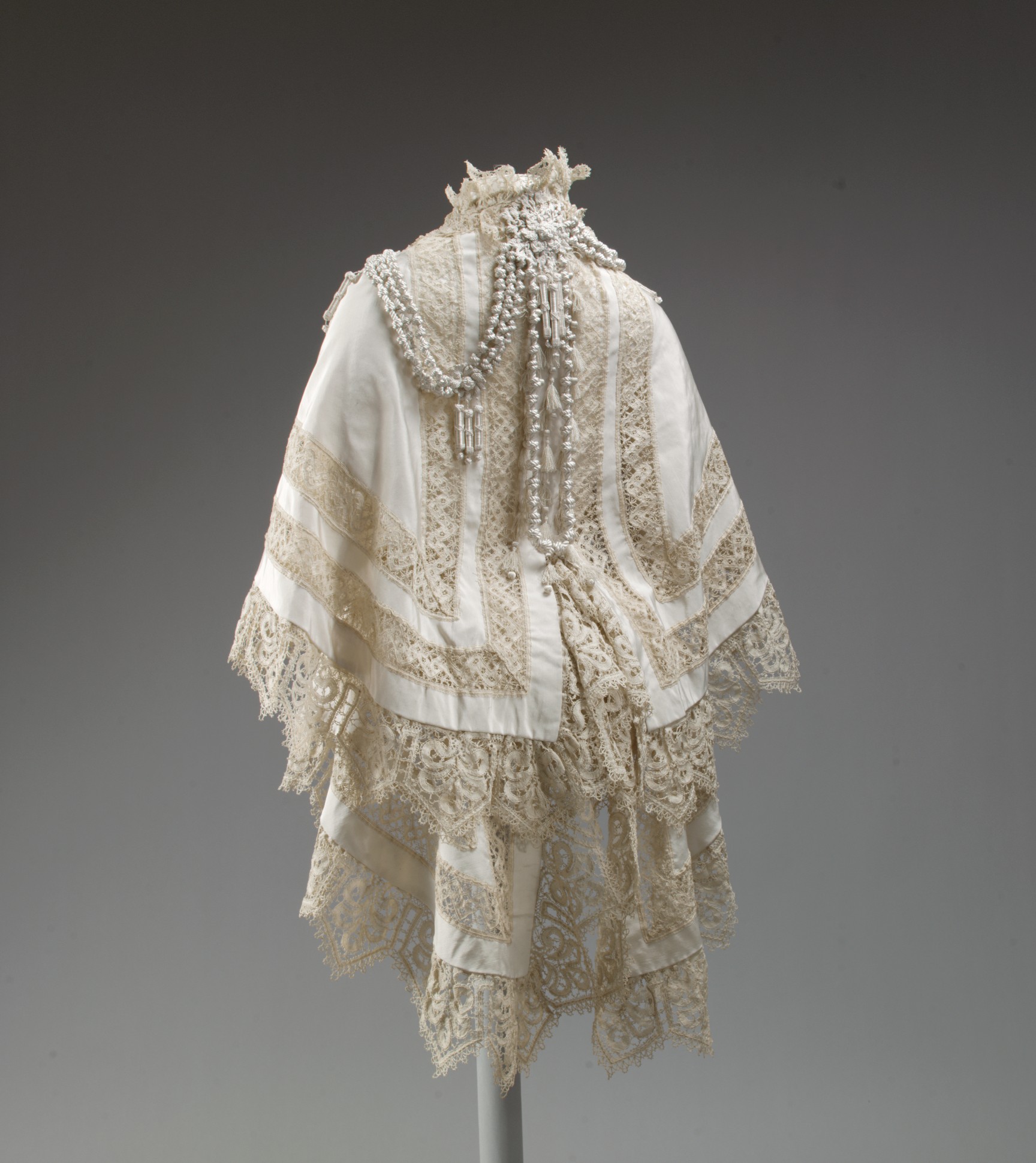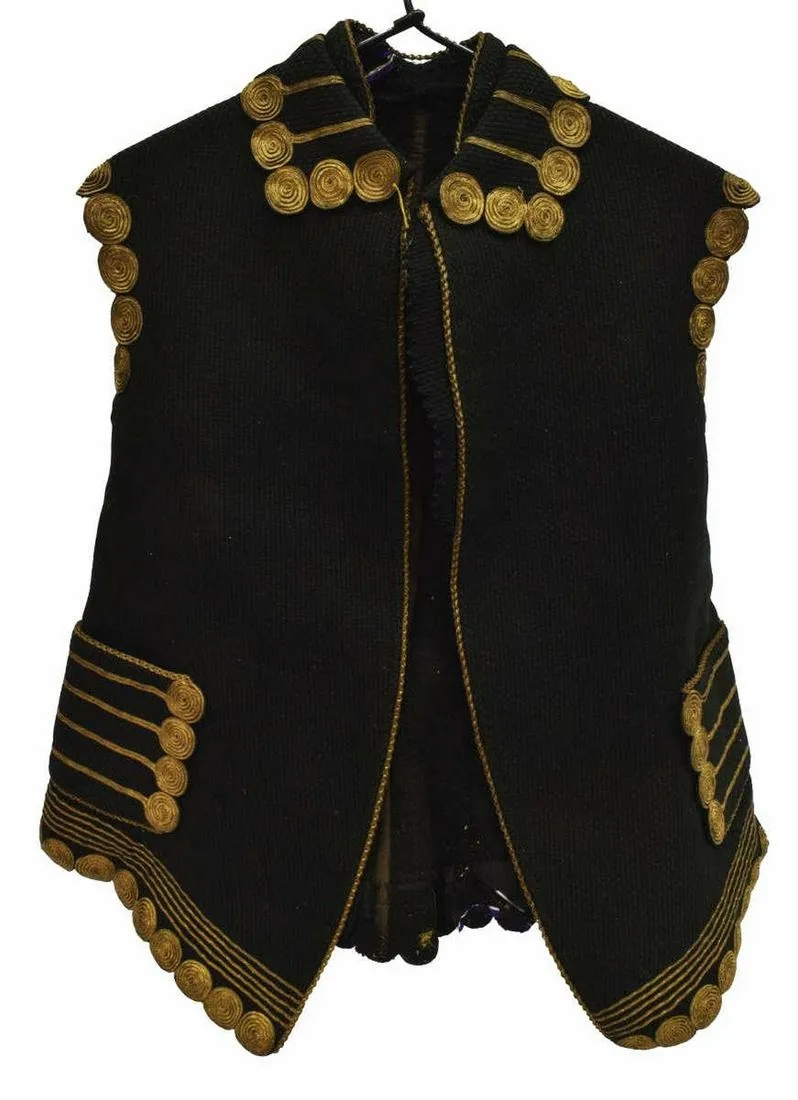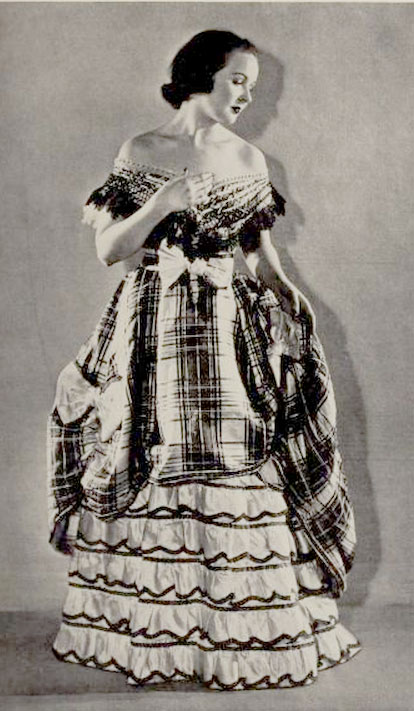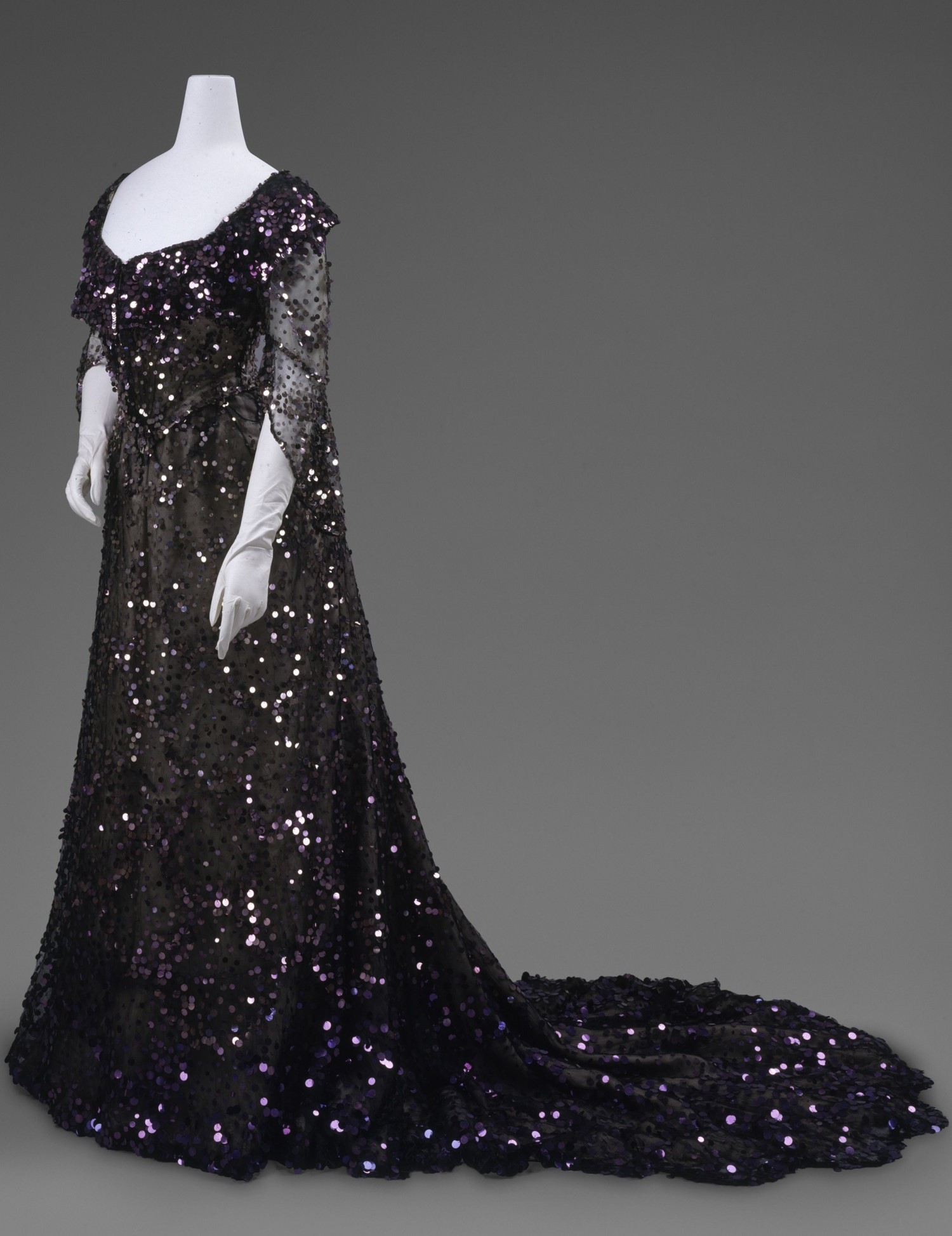Picking up from where Part I left off, this segment covers lots 31 to 70 of the 1937 auction of the clothing of Queen Alexandra of the United Kingdom (1844-1925). As before, I have highlighted items I have not been able to find in any collection, in yellow:
31. EMBROIDERED YELLOW SATIN AND HELIOTROPE STATE GOWN
Pale amber yellow satin embroidered with silver sequins and design of iris in appliqué silks painted heliotrope and pale green, outlined with crystal bugles; taffeta lining with chiffon flounce at hem. Bell-shaped separate skirt with train; pointed bodice with V-neck and tulle scarf sleeves. Worn during the Coronation year, 1902.
This veritable beauty of a gown is now part of the Royal Ontario Museum’s collection (figure 1.7):
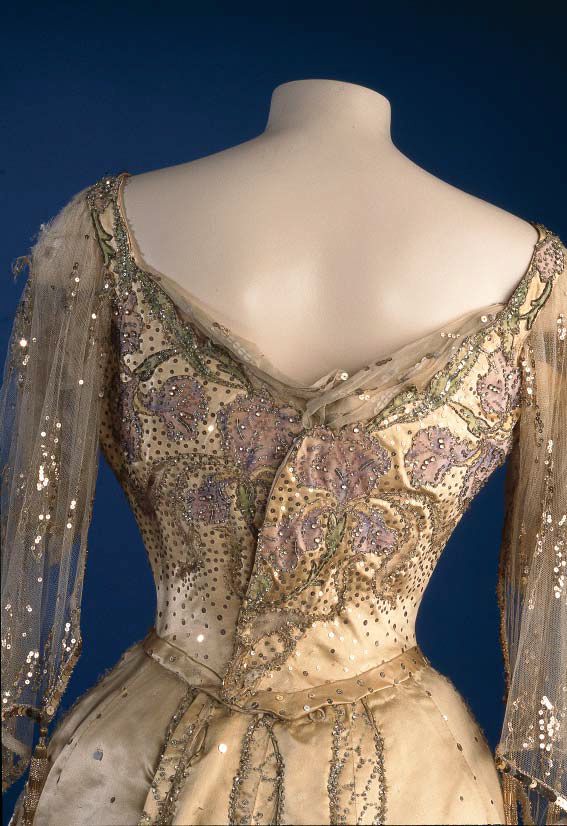

32. SHELL PINK WOOL DRIVING COAT
Heavy shell pink woolen coat, trimmed with pink braid, the edges trimmed with lappets. Part of H. M. Queen Alexandra’s trousseau.
Queen Alexandra would have worn such a coat to keep her warm and snug while riding in her carriage; unfortunately, its current whereabouts are unknown.
33. EMBROIDERED GOLD TULLE STATE GOWN WITH TISSUE FLOWERS
In one piece, with train and scarf sleeves; of pale yellow tulle appliqué embroidered with gold tissue flowers, tissue bands under tulle, and gold sequins and bugles; pale yellow satin and chiffon foundations. Worn at Buckingham Palace in 1907, on the occasion of the State visit of royalty, during the Kaiser’s visit in November, 1907, on the King’s birthday; among the guests were the Princess Royal, Duke of Connaught, Queen of Norway, the German Emperor, Prince of Wales, Princess of Wales, Princess Patricia, Princess Victoria, Prince Johann of Saxony, Prince Olaf, Grand Duchess Vladimir, and the Queen of Portugal.
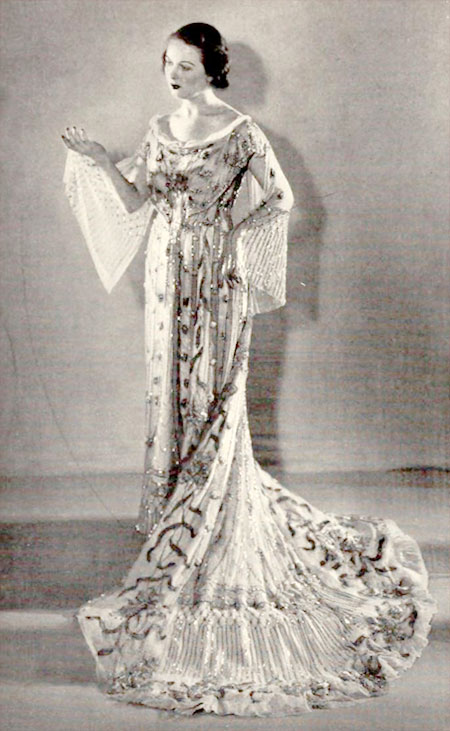
The dress now resides at the Met, as golden-looking and glorious as ever (figure 1.8):

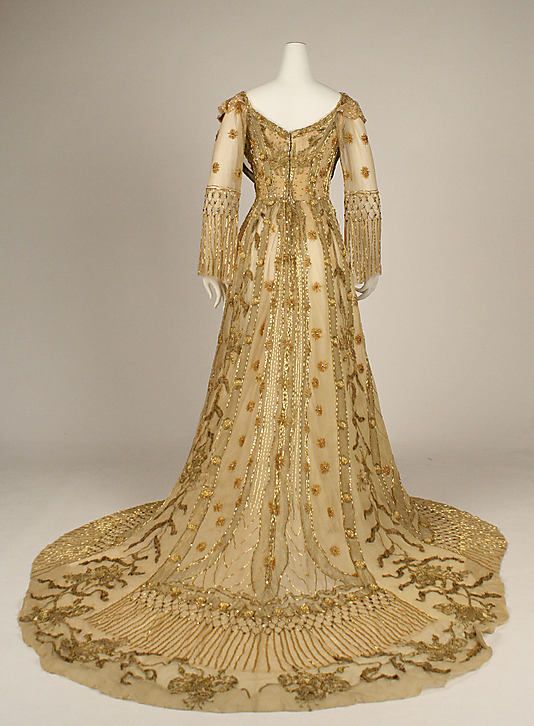
34. ROYAL BLUE SEQUIN AND TULLE GOWN
Embroidered with blue sequins and bugles on navy blue tulle with floral design; blue chiffon and black taffeta underdress. Separate skirt with train, and low-cut bodice overlapping in the front, with long scarf sleeves. Worn during the Coronation year; a favorite gown of Her Majesty’s, worn on many fashionable occasions, also for H. M. the King’s birthday.
Unfortunately, this is a gown that has yet to resurface since the 1937 auction.
35. BLACK AND GOLD SILK COAT
Black and gold silk woven in stripes with a plain gold panel in back; cut with high neck and bell sleeves; trimmed with gold frogs and claw buttons, and fringe. Yellow taffeta lining. Part of H. M. Queen Alexandra’s trousseau.
This is yet another of the coats from Queen Alexandra’s trousseau that awaits discovery.
36. EMBROIDERED WHITE SATIN STATE GOWN
Of white satin, back and front panels with appliqué borders of rose tissue covered with embroidered tulle bearing floral rinceaux in gold cordonnets and bugles. In one piece, with short rose tissue sleeves and square -cut neck. Worn by H. M. the Queen in Portugal (1904) on a visit to the King and Queen of Portugal; also worn for State visits and at the Grand Opera, Lisbon.
Yet another gown that is missing.
37. MAUVE SEQUIN AND TULLE GOWN
Of solid sequin embroidery with ribbon and bowknot motives in deeper mauve; chiffon and taffeta underskirts, with pleated flounces at hem; bodice with square-cut neck and puffed sleeves with lace flounce. Worn by H. M. the Queen during the Coronation year. 1902.
This sparkling princess-line gown in the Met’s online database corresponds with the description in the catalogue (see figure 1.9):


38. SILVER AND GOLD-EMBROIDERED BLACK TULLE STATE GOWN
Black tulle appliqué-embroidered with an allover design of curling silver floral branches, the blossoms heightened with gold; black satin foundation. Separate bell-form skirt with train, hem with tulle flounces; two printed bodices with puffed sleeves of tulle pique with sequins. Together with long detachable state train with similar embroidered border and tulle ruching. The gown and train were embroidered especially for H. M. Queen Alexandra by the wives of all the ruling princes of India, made up in Paris, and presented to her on her becoming Queen of England; worn for one of the Courts held after the Coronation, April 25, 1904. The Orders worn were the Order of the Garter, the Victoria and Albert, the Crown of India, St. John of Jerusalem, and the Danish Family Order.

The Met’s photographs of the black four-piece court gown in lot 38 of the auction show it both with and without its detachable train, as well as the two bodices (see figure 1.10):




40. SILVER-EMBROIDERED WHITE SATIN STATE GOWN
Richly embroidered with silver sequins and bugles, paste, and metal thread, with bands of flowers; separate bell-form skirt with train, printed bodice with white tulle scarf sleeves and décolletage. Worn by H. M. Queen during the Court held at Dublin Castle, July, 1903.
Yet another beautiful gown, if the above description is anything to go by, but unfortunately one that has been lost to the general public since 1937.
41. ROSE-PINK VELVET ROBE
Cut with full skirt and train, and long cape; trimmed with silver buttons and narrow galloon of silver sequins. Worn by H. M. the Queen at the wedding of the Grand Duchess Xenia, daughter of Czar Alexander III, to H.R.H. the Duke of Edinburgh, at Peterhof Palace.
This is a rather puzzling entry, considering that her brother-in-law Alfred, Duke of Edinburgh (1844-1900), married Grand Duchess Maria Alexandrovna of Russia (1853-1920), daughter of Tsar Alexander II, in 1874, not Grand Duchess Xenia Alexandrovna (1875-1960), who was Queen Alexandra’s own niece and did not marry until 1894! Nonetheless, one can safely assume that Queen Alexandra wore the dress in question to the 1874 wedding (which did take place in Russia), based on the fact that she wore the gown in lot 16 to Xenia’s nuptials (see Part I).
Although the “rose-pink velvet robe” currently remains unaccounted for, one can imagine what it would have looked like, thanks to Nicholas Chevalier’s (1828-1902) detailed study of the dress (figure 1.11), as well as his painting of the 1874 wedding ceremony (see figure 1.12). In the handwritten notes accompanying the study, Chevalier draws the viewer’s attention to the silver brocade silk of the skirt and the rose velvet of the overskirt (which would have lengthened itself into a court train), embellished with silver-embroidered roses, shamrocks and thistles.


42. SILVER-EMBROIDERED LIGHT GRAY WOOL CAPE
Of pale gray cloth with upstanding collar, with Turkish embroidery in silver; blue sateen lining. Part of H. M. Queen Alexandra’s trousseau.
Another item from Queen Alexandra’s trousseau that has not been seen since the 1937 sale.
43. GOLD AND SILVER EMBROIDERED WHITE TULLE STATE GOWN
White tulle embroidered in gold and silver sequins and bugles and with festoons of delicate opalescent gold flowers; fastening in front with a narrow plain panel of white chiffon; short sleeves, square-cut neck. With train. Worn at Buckingham Palace for State visits.
The whereabouts of this gown are also unknown.
44. BLACK CHIFFON AND BLUE AND SILVER SEQUIN GOWN
Of black chiffon overlaying light blue chiffon on a black satin foundation; embroidered in blue and silver sequins with a large shaded floral design. Separate bell-shaped skirt with train; two bodices, one with short sleeves trimmed with black lace, the other décolleté with short black tulle sleeves. Worn at Buckingham Palace and Windsor Castle.
This three-piece gown is missing as well.
45. DANISH WHITE WOOL AND LAMB DRIVING COAT
With wide borders and deep collar of white lamb; trimmed with gold braid and frogs, lined in light yellow taffeta. Part of H. M. Queen Alexandra’s trousseau.
Pictures of this driving coat, now part of the Met’s costume collection, can be seen in figure 1.13:


46. EMBROIDERED BLACK TULLE GOWN
With heavy chain-stitch and appliqué velvet embroidery in black; satin underskirt. In one piece, with train, square-cut bodice and puffed sleeves. Said to have been H. M. the Queen’s favorite dinner gown, worn at Christmas and Easter at Sandringham.
Lot 46 was the last of Queen Alexandra’s gowns on offer and like so many of the others in this auction, there has been no sign of it since it was sold.
54. CORAL SATIN AND LACE APRON
Composed of satin lappets with ruching and écru lace borders. Part of H. M. Queen Alexandra’s trousseau.
In November 2020, this so-called apron featured in an auction of Hollywood memorabilia. Even more unbelievably, the auctioneer, Profiles in History, referred to the item as a collar and even presented it as such on a mannequin (see figure 1.14). Nevertheless, the lot description provides a fuller picture of the object’s provenance by supplying the inscription on the internal bias label: “1902 P-A-I. Worn by H. M. Queen Alexandra. Part of her trousseau. Purchased through Samuel Wilson Soden – May 5 – 1937 Traphagen School.”1 In all likelihood, an inventory of Queen Alexandra’s former wardrobe as Princess of Wales was carried out in 1902, the year of her coronation, and so it is plausible that “P-A-I” stands for “Princess Alexandra Inventory.” New York’s Traphagen School of Fashion, which existed between 1923 and 1991 and trained well-known American designers,2 bought the “collar” at the 1937 auction, as indicated by the garment’s label, and most likely added it to its study collection.
Costume historian Kate Strasdin has pointed out that the garment, which is now in a private collection, is not a collar, cape or apron, but rather a peplum that would have been worn over an 1860s skirt.3

It is disappointing that even now, decades later, with fashion researchers, historians and collectors on the hunt for Queen Alexandra’s clothing, so many pieces from the 1937 sale have yet to turn up. Feel free to write back if you know where any of them may be located.
Notes
1. “Queen Alexandra of Denmark Satin and Lace Collar. – Nov 12, 2020 | Profiles in History in CA,” LiveAuctioneers, accessed January 10, 2024, https://www.liveauctioneers.com/item/91727606_queen-alexandra-of-denmark-satin-and-lace-collar.
2. “The Traphagen School: Fostering American Fashion | Fashion Institute of Technology,” The Museum at FIT, accessed January 10, 2024, https://www.fitnyc.edu/museum/exhibitions/traphagen-school.php.
3. Kate Strasdin, December 28, 2023, comment on Faiza Mahmud, “A 1937 Auction of Queen Alexandra’s Clothing (Part I),” Lost and Found (blog), January 29, 2022, https://dressingroyalty.wordpress.com/2022/01/29/a-1937-auction-of-queen-alexandras-clothing-part-i/; Dr Kate Strasdin (@kateStrasdin), “This is a curiosity. Selling at auction @pihauctions next month & belonging to Alexandra, #PrincessofWales, it was originally sold at a famous auction,” Twitter, October 29, 2020, 2:29 p.m., https://twitter.com/kateStrasdin/status/1321745851459522560. Pointing out that the word “peplum” first came into use in 1866, the Oxford English Dictionary defines it as, “The part of a woman’s jacket or tunic which hangs below the waist; a jacket or tunic having such a design,” before going on to describe it as “†a kind of overskirt resembling the ancient peplos (obsolete).” This latter, now defunct, definition seems to apply in this context.
Bibliography
American Art Association-Anderson Galleries, Inc. Royal Robes and State Gowns, Including Toilettes Worn at the Coronation and from the Trousseau of H. M. Queen Alexandra, Comprising Coats, Kashmir Shawls, Bags, Gloves and Embroidered Slippers, with Other Examples of the Richest Fashions of the Period from 1863 to 1907: Auction in New York, May 5, 1937. New York: American Art Association-Anderson Galleries, 1937. https://archive.org/details/royalrobesstateg00amer/page/n3/mode/2up.




